| | Bloom stage identification | Sclerotinia stem rot checklist | Actual loss assessment
Around five million acres of canola are now grown annually in Alberta. Sclerotinia white stem rot is one of the most destructive diseases of this crop. To help canola growers predict outbreaks of sclerotinia white stem rot, a disease forecast system was developed. The forecast system is a checklist that assists growers to make a decision on the need for applying a foliar fungicide. The check list came into being as a consequence of disease control trials carried out in 1981 and 1982.
Table 1. Control of sclerotinia with aerial application of fungicide in canola
Average (%) of diseased plants |
| Species & fungicide | Yield (bu/ac) | Yield increase (bu/ac) |
treated | untreated |
| Argentine (Brassica napus) |
| Benlate | (3) | 43.3 | (56) | 23.1 | 20.2 |
| Benlate | (7) | 23.3 | (70) | 14.5 | 8.8 |
| Benlate | (11) | 29.6 | (76) | 16.1 | 13.5 |
| Benlate | (6) | 39 | (19) | 35.3 | 3.7 |
| Rovral | (10) | 23 | (70) | 14.5 | 8.5 |
| Rovral | (4) | 38 | (19) | 35.3 | 2.7 |
| Rovral | (3) | 31.3 | (31) | 24.9 | 6.4 |
| Polish (Brassica campestris) (B. rapa) |
| Benlate | (2) | 28.8 | (18) | 31.6 | -2.8 |
| Benlate | (8) | 42.8 | (44) | 31 | 11.8 |
| Rovral | (1) | 30.9 | (18) | 31.6 | -0.7 |
| Rovral | (2) | 37 | (44) | 31 | 6 |
Table 2. Fungicides for control of sclerotinia in canola
| Fungicide | Produce rate | Minimum water volume |
 | (grams/acre) | mL/acre | ground | air |
| Benlate | 405 - 605 |  | 32 - 40 L/ac | 16 L/ac |
| Rovral | 400 - 600 | 800 - 1200 | 40 L/ac | 18 L/ac |
| Ronilan | 310 - 415 | – | – | 16 L/ac |
Research results indicate that it may be economically justifiable to apply fungicide when field scouting indicates that disease levels will reach 15 per cent in Brassica napus (Argentine canola) and over 30 per cent in B. campestris (Polish canola) by crop maturity. This figure is based on a $8 return per bushel ($353 per tonne) and an application cost of the fungicide at around $22 per acre ($55 hectare).
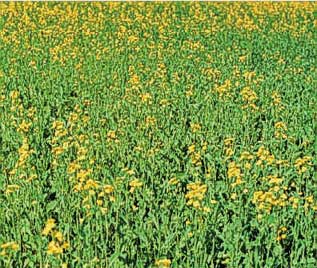 |  | 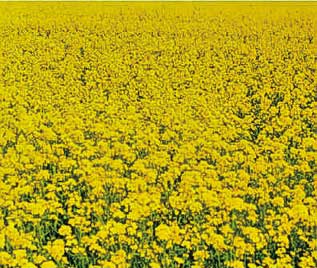 |
| Figure 1. Canola field in 1 to 2 per cent bloom |  | Figure 2. Canola field in 30 per cent bloom |
Because the fungicide must be applied before symptoms of stem rot are visible, at the 25 to 30 per cent bloom stage of the crop, a grower must attempt to determine the economics of a fungicide application. This checklist is not always reliable because sudden weather changes can cause infestations to occur unexpectedly or high risk fields may show limited disease development. However, this checklist gives practical direction in making the decision to apply fungicide.
Bloom Stage Identification
If you plan to apply fungicide for sclerotinia control, you must decide when to spray. Sample several plants over the field and assess the number of open flowers. One way to check for bloom stage is to find the main stem, pull off the secondary branches, and count only the open flowers on the main stem. Generally, it takes a crop from two to four days to move from first flower to 10 per cent bloom.
Table 3. Identification of flowering stages of canola
Flowering
stage | Argentine canola
(flowers-main stem) | Polish canola
(flowers-main stem) |
| 10% | 10 | 7-Jun |
| 20% | 14 - 16 | 12-Oct |
| 30% | 20 | 14 - 16 |
At 30 per cent bloom, a field of canola is said to be fully flowered, when the maximum number of flowers are open at one time.
The best control from a fungicidal application occurs before the majority of petals begin to drop off and the pods set. The fungicide provides protection to the plant for at least nine days when applied at 20 to 30 per cent bloom stage. Because of the very short time of four to eight days from first flower to 20 to 30 per cent bloom, a custom applicator should be booked as early as possible unless you apply the fungicide yourself.
The objective of the fungicide application is to cover as many petals as possible. Put another way, the crop should be sprayed at its yellowest, the day(s) when the maximum number of flowers are open.
When petal fall takes place it allows the maximum number of fungicide-covered petals to fall into the canola canopy (lower leaf axils, leaves and shoots), taking the fungicide along. Infection of the canola plant will only take place from sclerotinia infected petals. When the petals fall into lower leaf axils the presence of one or more petals carrying fungicide will likely prevent sclerotinia infection.
Fungicide application rates for both ground and aerial application are detailed in the text Crop Protection, Agdex 606-1.
Sclerotinia Stem Rot Checklist
When to complete the checklist
Fill out the checklist and assess the crop shortly after first flower. First flower occurs when 75 per cent of the canola plants have three open flowers on the main stem. Usually this occurs during the last week of June or the first week of July.
How to complete the checklist
Read one question and circle the point value assigned to the answer you would choose for each section. Count up the points and enter the total for each section. Answer all the questions.
Section one
| 1. | Have you had good looking crops at flowering and poor yields at harvest, even though growing conditions were favorable? |
 | Yes – 20 | No – 0 |  |
| 2. | Have you seen sclerotinia stem rot in your crops in previous years? |
 | Yes – 20 | No – 10 |  |
| 3. | Have you heard of sclerotinia problems in your area in the past two to three years? |
 | Yes – 10 | No – 5 |  |
| 4. | Have you seen black sclerotes in your harvested seed in the past two to three years? |
 | Yes – 20 | No – 10 |  |
| 5. | In previous years have your canola crops lodged? |
 | Heavily – 20 | Moderately – 10 | Lightly – 0 |
| 6. | Do you see large swaths at harvest but get low yield? |
 | Yes – 10 | No – 0 |  |
| 7. | If you sprayed a sclerotinia fungicide in previous years, what were the results? |
 | Better crop – 20 | No difference – 0 |  |
.
Total points for section one ______________
If you scored 60 or more in this section you probably had sclerotinia stem rot in your canola crops. Proceed to section two with a 60 or more score. |
.
Section two
. |
| 8. | When you walk through the crop during the morning at the beginning of flowering, are your boots and pant legs wet when you come out? |
 | Yes – 20 | No – 10 |  |
| 9. | Have you had wet weather in the immediate areawithin 2 to 3 weeks prior to flowering that allowed the soil to remain moist for extended periods? |
 | Yes – 20 | No – 10 |  |
| 10. | Were apothecia found in the field, around the field, or in any neighbouring cereal or canola fields where canola was grown in the previous 1 to 3 years? |
 | Yes – 20 | No – 10 |  |
| 11. | Do you feel it will be dry throughout the flowering stage of the crop? |
 | Highly likely – 0 | Moderately likely – 10 | Not likely – 20 |
.
Total points for section two ______________
.
If you had a high score in section one and more than 50 for section two, you should consider applying a fungi-cide to protect your crop against sclerotinia stem rot. |
.
Section three
. |
| 12. | What is the condition of your stand of canola in terms of height, vigor and uniformity? |
 | Excellent – 20 | Good – 10 | Fair – 5........................Poor – 0 |
| 13. | When you walk through your crop, how dense is the canopy? |
 | Light – 0 | Moderate – 10 | Very dense – 20 |
| 14. | What is the yield potential of the stand? |
 | 10-20 bu/ac – 0 | 20-30 bu/ac – 10 | Greater than 30 bu/ac – 20 |
| 15. | In previous years, when your yield potential was30+ bu/ac, what were the actual yields? |
 | Greater than 30 bu/ac – 0 | 20-30 bu/ac – 20 |  |
.
Total points for section three ______________ |
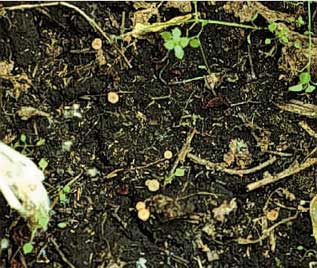 |  | 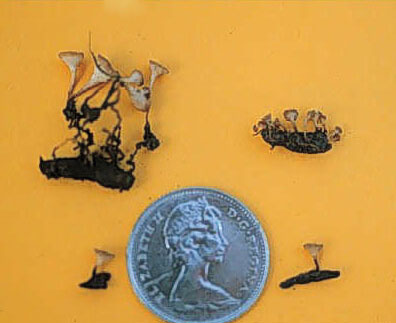 |
| Figure 3. Apothecia – the fungus spore producing structures at the base of the crop |  | Figure 4. Apothecia arise from sclerotes, which may be buried in or on the soil surface (a dime) |
| . |  |  |
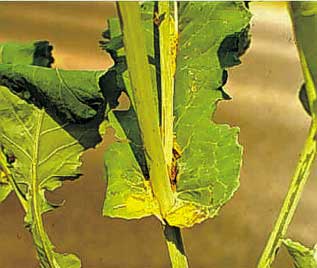 |  | 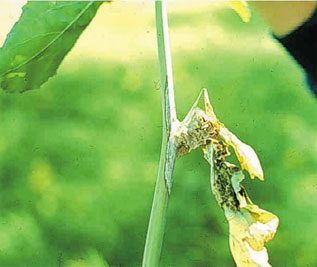 |
| Figure 5. Canola petals fall into leaf axils |  | Figure 6. Infection takes place in leaf axils if untreated |
If you have scored 50 or higher in section three, along with high scores from the first and second sections(60 and 50 plus respectively), it may be worthwhile to protect your crop against sclerotinia stem rot. If you scored less than 50 in the last section it is not likely worth applying a foliar fungicide.
Growers can apply fungicide for sclerotinia control and achieve good to excellent results in the standing crop. Unfortunately, this disease may progress rapidly in the swath in wet years particularly in Argentine cultivars.Do not swath canola if rain is forecast, particularly if the crop is immature (green) when cut. In wet, compacted swaths, particularly on the turns, sclerotinia rot progresses rapidly. The disease can be detected by a rotten “egg like” smell coming from the swaths. This problem is obviously more prevalent in the wetter regions of the province. The heavier and more compact the swath, the greater the likelihood for sclerotinia to rot the swath before combining.
Control of sclerotinia (in the swath)
- Direct combining.
- Do not swath immature stands (at least 30% of the seed must be ripe).
- Do not swath if rain is in the immediate forecast.
- Avoid compacting swaths.
- Use a high cut to allow for better drying.
- Avoid heavy swaths on the turns.
Up to one-third of a canola crop may be lost in the swath due to sclerotinia rot. Additionally, this damages and reduces the quality of the grain and increases the number of sclerotes.
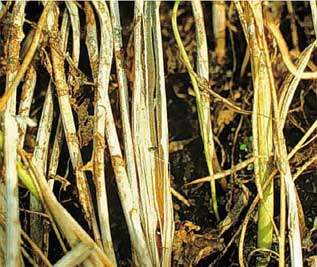 |  | 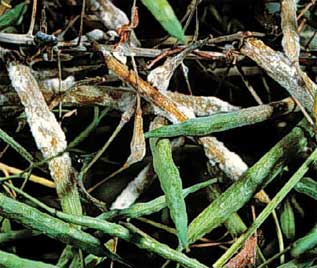 |
| Figure 7. Heavy infection can occur particularly if the crop lodges |  | Figure 8. Sclerotinia infection can occur under swaths especially during wet harvest seasons |
| . |  |  |
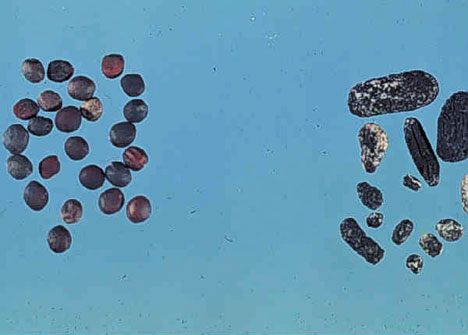 |  |  |
| Figure 9. Sclerotes may be harvested with the grain, but most are left in the field |  |  |
.
Actual Loss Assessment
An Argentine canola field with a 50 per cent main stem infection would have an approximate yield loss of 25 per cent: 50 x 0.50 = 25. The actual yield losses depend on the variety, weather and time of infection. Thus a 40 bu/acre crop with a 50 per cent infection level would give a yield loss of 10 bu/acre. Actual losses in Polish canola may be lower for comparable levels of infection to Argentine types.
Prepared by:
Alberta Agriculture and Food
Source: Agdex 149/632-4. Revised July 2007. |
|